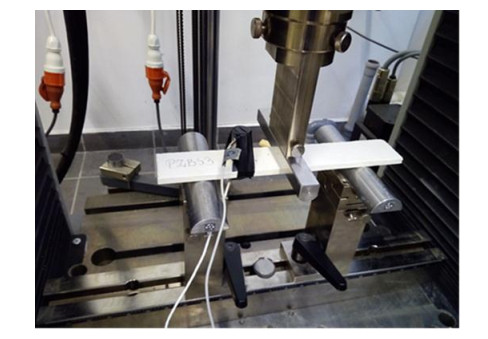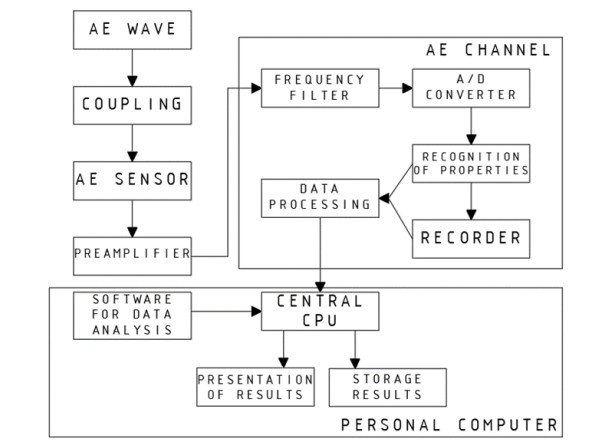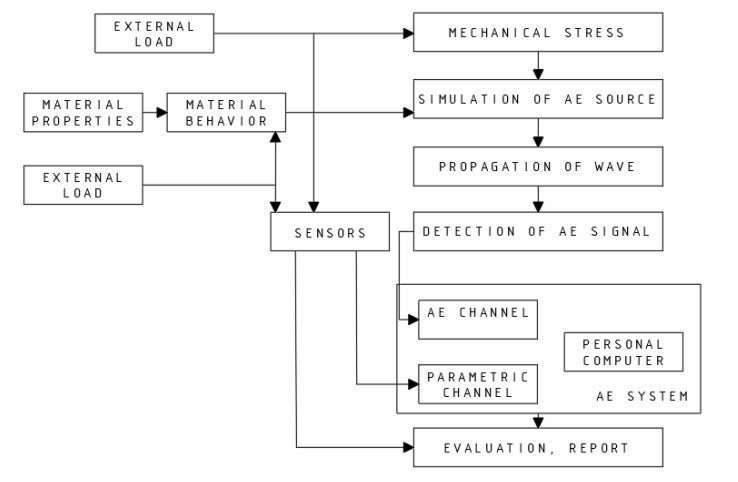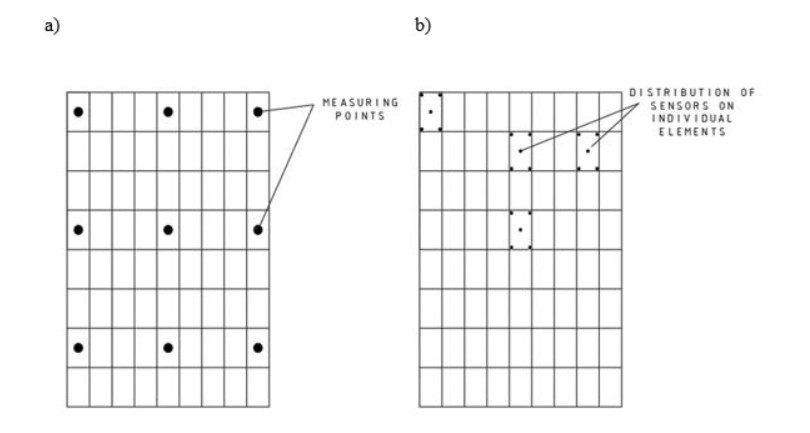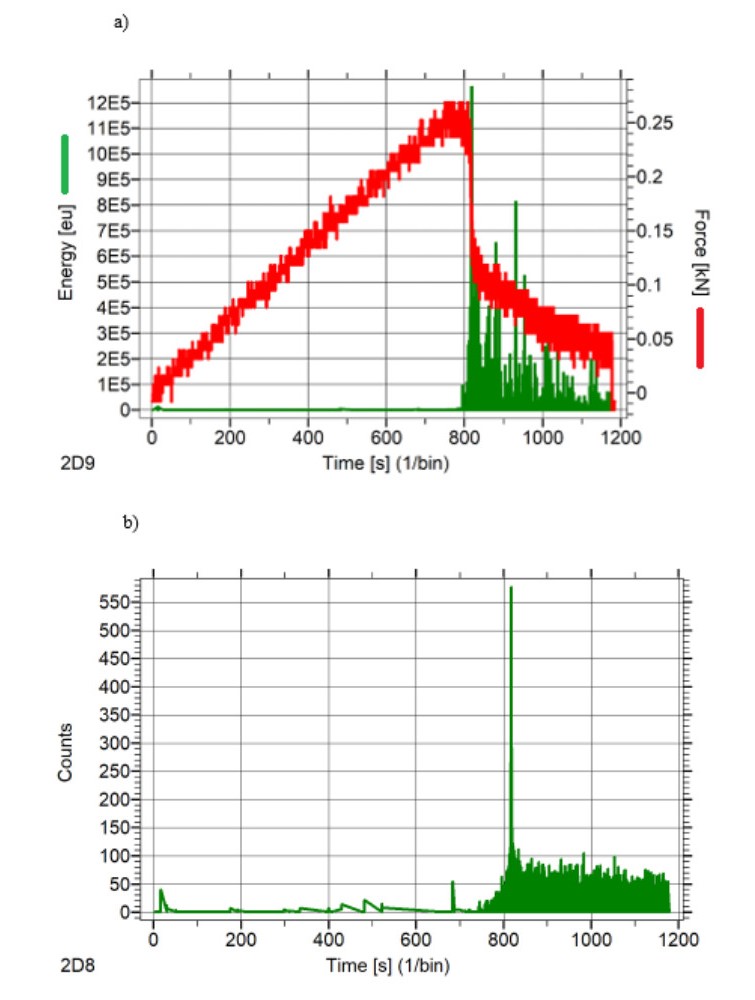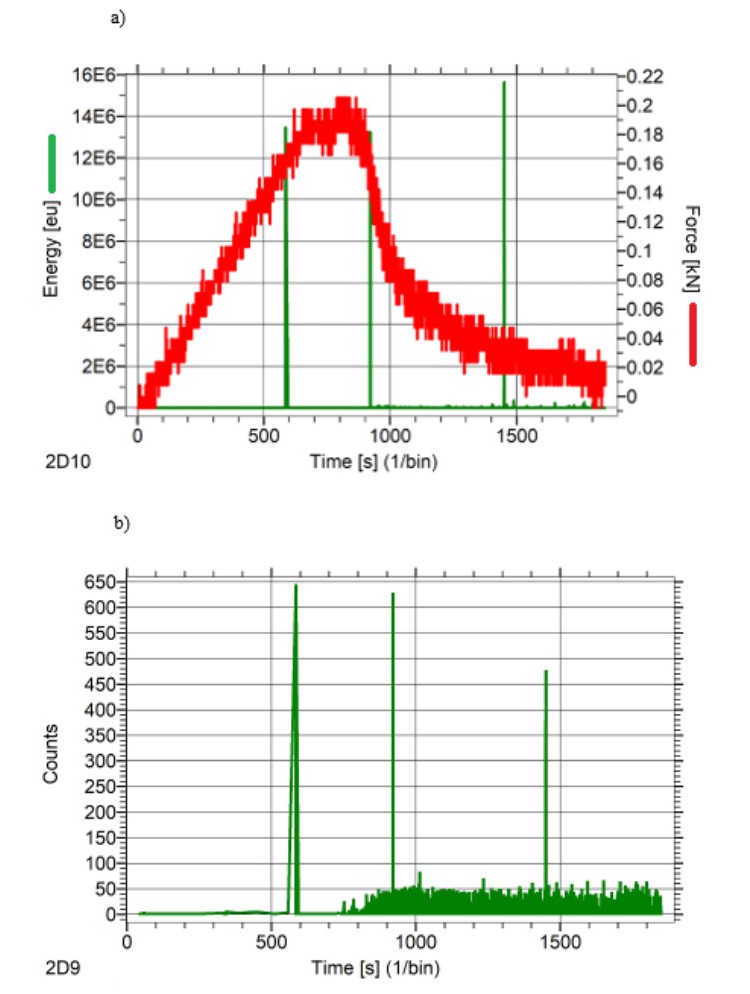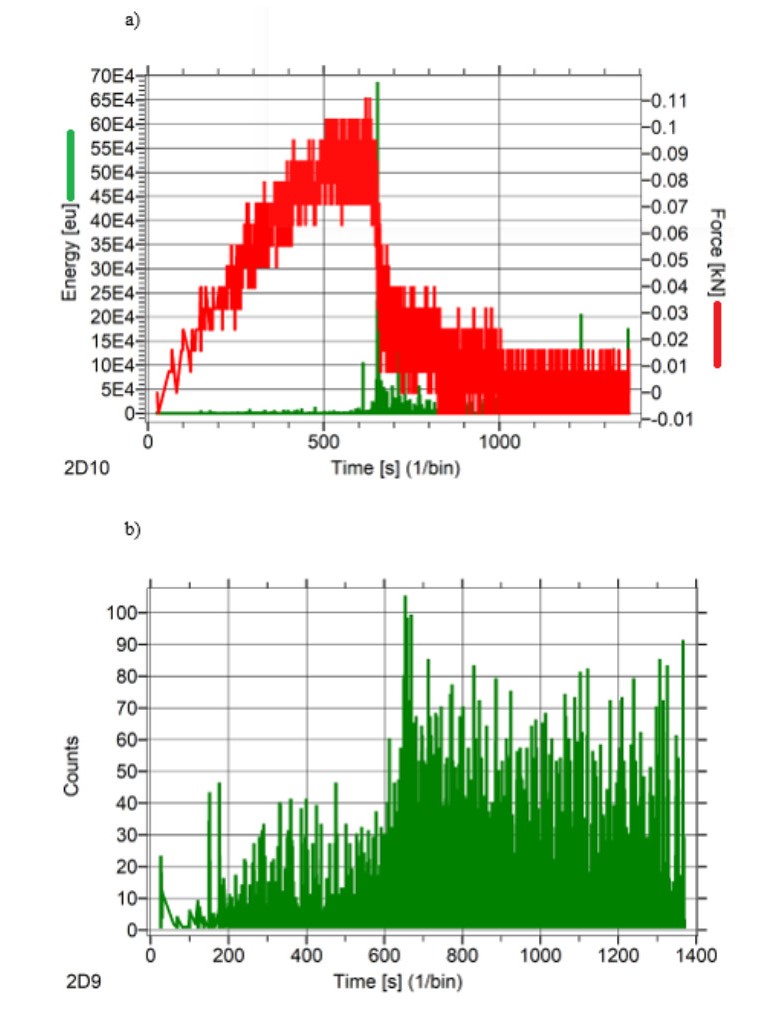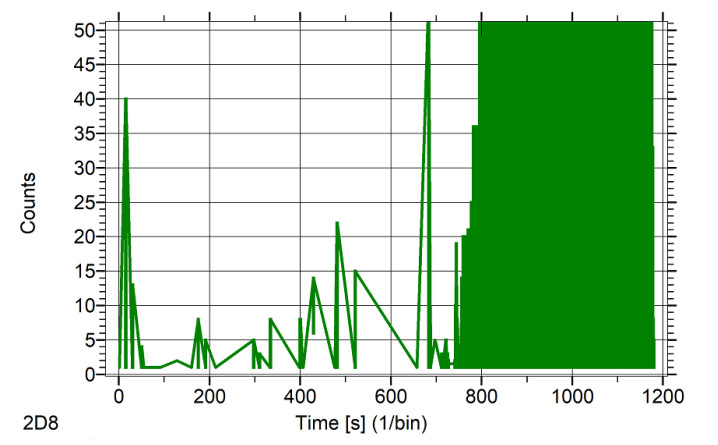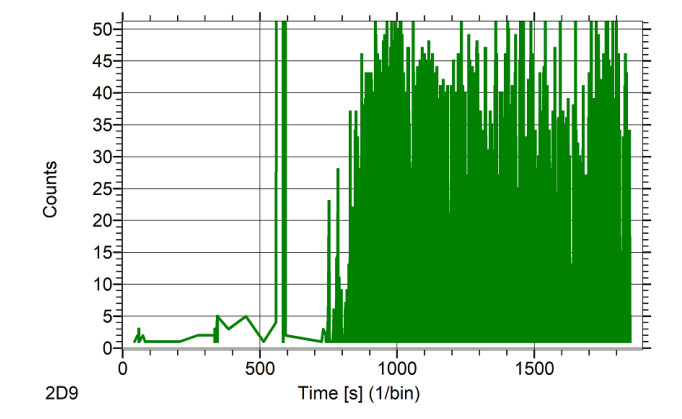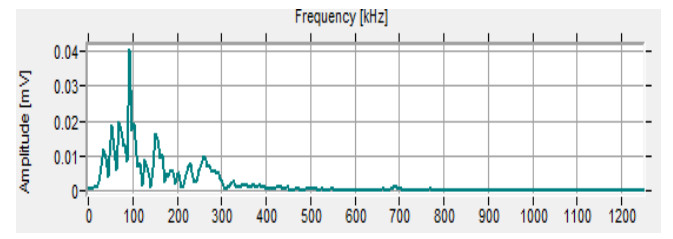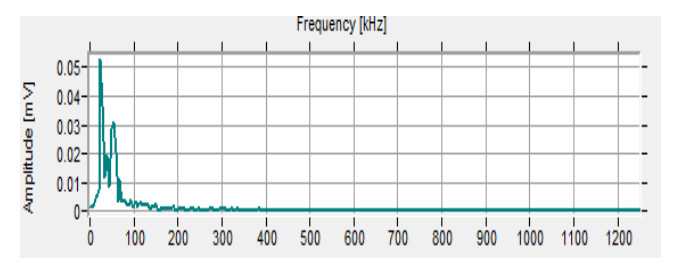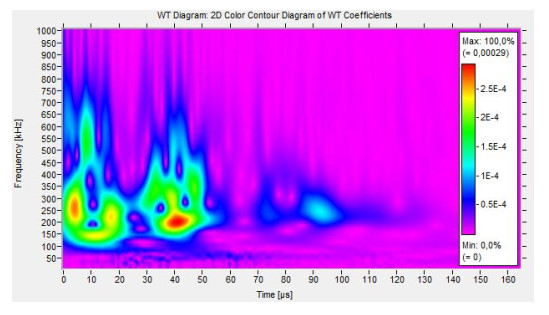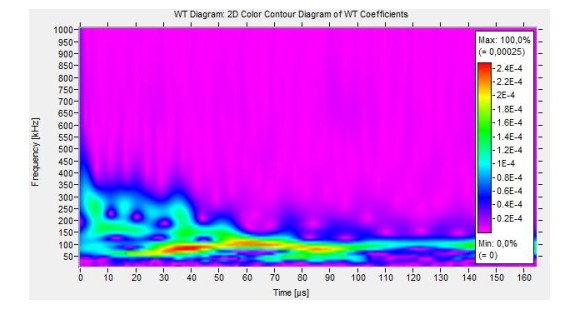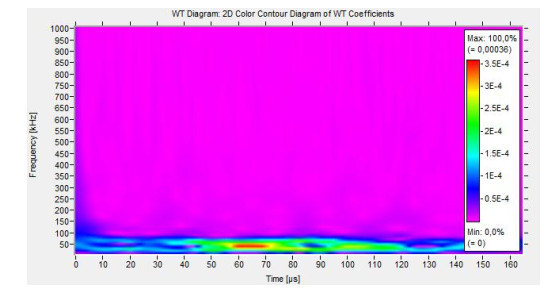Fiber-cement building products are increasingly used in construction. They are used as building and finishing material for facades, internal walls and roofs. Numerous advantages such as relatively low weight, low absorbability and relatively high strength allow to use these materials in bulky constructions and in buildings which are commonly considered tall. Safety reasons, however, point to the need to control the condition of materials used to erect such structures. It is also in line with the more and more widely implemented concept of monitoring the state of the structure and its components over their entire period of use (SHM). The article presents the results of experimental tests on flexural strength of cement-fiber boards in an air-dry state, which have been soaked in water for 24 hours and subjected to high temperature. The paper also presents a possibility to use a non-invasive method of acoustic emission and wavelet analysis for testing cement boards reinforced with cellulose fibers. Obtained results allow to track the change of mechanical parameters in boards subjected to environmental and exceptional factors. These results also confirm the applicability of the presented methods as instruments for observing the condition of the panels used.
1.
Introduction
1.1. Autism Spectrum Disorder (ASD)
Autism spectrum disorder (ASD) is a developmental disability characterized by marked deficits in social communication and interaction, including limited and repetitive patterns of behavior. The term spectrum indicates the wide range of symptoms and severities associated with the condition. According to a report published by Centers for Disease Control and Prevention (CDC) [1], the prevalence of ASD among children 8 years of age was 16.8 per 1,000 (one in 59) for 2014 in the USA. The prevalence of ASD varied by race, ethnicity and gender. Males were four times more likely than females to be identified with the condition. Also, when non-Hispanic white children were compared with non-Hispanic black children, the prevalence was higher for non-Hispanic white children. Similarly when the groups are compared all together, ASD was found to be more prevalent in non-Hispanic white children and non-Hispanic black children than in Hispanic children [2].
1.1.1. Causes of ASD
Although ASD has multiple possible causes, many cases are idiopathic. ASD can be associated with genetic, environmental, or idiopathic influences. ASD currently includes many conditions that were previously categorized under a variety of terms including autistic disorder, Asperger's syndrome [3], pervasive developmental disorder, childhood disintegrative disorder (Heller syndrome), fragile X syndrome, Rett syndrome, and tuberous sclerosis [4]. Some of the other risk factors linked with autism are genetic mutations, having an immediate family member with autism, genetic disorders, older parents, exposure to environmental toxins and heavy metals, low birth weight, fetal exposure to valporic acid or thalidomide, metabolic imbalances, and a history of viral infections. Both genetics and environmental influences likely predispose a person to develop autism.
1.1.2. Symptoms of ASD
ASD typically begins in early childhood. The symptoms often present by 12 months to 18 months of age or earlier [5]. The word spectrum is used because there is a wide range of similar features in individuals with the condition. Some may have milder symptoms, while others may have more severe symptoms. Despite the variability of symptoms from person to person, there are certain behaviors and actions which are common. The salient signs and symptoms include problems with communication, social interactions, and a restricted range of behaviors and interests [4],[6]. Symptoms are divided into two main categories as follows [7]:
Issues with communication and social interactions. These include:
-
Problems with communication, includes difficulty sharing emotions and interests or keeping up with a back and forth conversation;
-
Problems with non-verbal communication, includes trouble with eye contact or reading body language;
-
Problems with developing and keeping up with relationships [7].
Problems due to restricted or repetitive patterns of behavior. These include:
-
Repetition of movements, motions, or speech patterns.
-
Addiction to specific behaviors or routines;
-
Sensitivity to a specific sensory information;
-
Fixed pre-occupations [7].
An individual must display all three symptoms in first category and atleast two sysmptoms in the second category to be diagnosed with ASD. A marked delay in language or social development may be an early symptom of ASD. A subset of people with ASD can present with repetitive adventitious movements [8]–[11], which may include hyperkinetic disorders [12],[13], self-injurious behaviors (SIBs), and catatonia [14]–[17].
1.1.3. Diagnosis and clinical assessment of ASD
The diagnosis is suggested by the history and confirmed by the interview and examination of the patient and the parent [4],[18]. The updated criteria for ASD diagnosis are published in the Diagnostic and Statistical Manual of Mental Disorders, Fifth Edition (DSM-5) [19]. Many tools have been used to diagnose autism such as the Autism Diagnostic Interview-Revised (ADI-R) [20],[21], the Autism Diagnostic Observation Schedule (ADOS) [22],[23], the Childhood Autism Rating Scale (CARS) [24], and the Gilliam Autism Scale [25]. For clinical diagnosis, the ADI-R [20],[21], a structured maternal interview, and the ADOS [22],[23], a structured interactive activity with the participant with or without the parent, remain the gold standard [18]. The tool which fits the revised DSM-5 criteria the best is the ADOS-2 [5],[23]. Since inheritance plays a role in the pathogenesis of ASD, genetic influences are crucial to identify in ASD. Additionally, neurotransmitter systems are crucial components of the pathophysiology of ASD. Because the genetics of ASD and the neurotransmitter systems in ASD are complex topics that merit separate articles, they are beyond the scope of this article.
1.1.4. Imaging for ASD
Neuroimaging techniques are mainly divided into structural and functional [26],[27]. Structural techniques include radiographs (x-rays), computed tomography (CT), magnetic resonance imaging (MRI), and diffusion tensor imaging (DTI) [27]. Functional techniques, include the nuclear neuroimaging tools of positron emission tomography (PET) and single-photon emission computed tomography (SPECT) [27], and various magnetic resonance techniques to facilitate visualization of metabolic components of the nervous system [18],[26],[27]. This article will focus on nuclear molecular neuroimaging techniques, specifically, PET and SPECT [18],[26]–[29].
1.2. Nuclear molecular imaging
This article will focus on positron emission tomography (PET) and single-photon emission computed tomography (SPECT). PET and SPECT play key roles in nuclear molecular imaging because of their high sensitivity, good spatial resolution, and penetration depth [30]. For definitions of nuclear molecular imaging terminology, please refer to Figure 1.
1.2.1. Positron emission tomography (the Molecular Basis of Positron Emission Tomography [31])
Positrons and electrons are some of the tiny particles that make up atoms. As the name implies, positrons carry a positive electrical charge whereas electrons carry a negative electrical charge. Positrons are contained within the nucleus of each atom and can be released from atoms during the decay of unstable, radioactive atoms or molecules. The positrons can then be detected by scanners with sensitive cameras. Radioactive decay is the basis of PET technology.
The radioactive compounds required for PET (also called radiotracers) are generated in a cyclotron—a sophisticated machine to damage the nuclei of chemicals. Directly after their synthesis, the PET radiotracers already begin to decay and release positrons in the process. Because the radiotracers used for PET generally decay very rapidly, PET is an extremely expensive procedure available only at selected facilities with or near cyclotrons. Small amounts of the radiotracer are injected into the participant's bloodstream, which distributes the tracer to the tissues, and the participant is placed in the PET scanner.
During the radioactive decay of the radiotracer, the released positrons collide with electrons, resulting in the production of two particles of light (i.e., photons). Sensors within the PET scanner detect the photons, and attached computers with sophisticated software can use this information to identify the position of the original positrons. With the help of computed tomography obtained immediately before the PET (Figure 2), the computer can then generate three-dimensional images of the source of the photons [26]. The computer also counts the collisions between positrons and electrons at each site in the brain, and these counts are proportional to the amount of radiotracer present at that site. For example, one can generate radiotracers that specifically bind to receptors for the neurotransmitters dopamine or serotonin. These radiotracers will bind to the receptors, with higher concentrations of the radiotracers accumulating in those brain regions that contain higher concentrations of the respective receptors. With this approach, investigators and clinicians can estimate the density and the distribution of particular neurotransmitter receptors in the living human brain. Currently available PET cameras can theoretically distinguish structures that are only 2 mm apart [26],[31].
1.2.2. Single-photon emission computed tomography
SPECT differs from PET in the use of gamma (single-photon) emissions, including 99mTc. SPECT has many disadvantages when compared with PET. Resolution of SPECT is inferior to PET. The quality of images for SPECT is markedly inferior to PET because the resolution, the minimal detectable distance between two points, is around 1 cm for SPECT and approaches 2 mm for PET [18].
In SPECT, less sensitive lead collimators obtain positional information from photons in pre-defined direction. Lead collimators end up decreasing sensitivity. Also sensitivity and spatial resolution are position dependent; as the depth in the body increases, they decrease. Attenuation correction methods are more burdensome as the path length through tissue is unknown. Further disadvantages include the absence of single-photon emitting isotopes of basic biological origin and the use of radionuclides that are foreign to the human body such as Tc-99m. The fate of this radionuclide is not similar to native molecules and can result in interpretation problems, i.e., for oxygen and glucose metabolism no satisfactory radiotracers are available [33]. Advantages of SPECT include the easy availability of equipment and radionuclides in nuclear medicine departments. SPECT radionuclides have longer half-life than PET. Therefore, SPECT radionuclides can be transported from distant sources for use in community health centers. PET often utilizes radiotracers with short radionuclide half-lives requiring production in an on-site cyclotron. SPECT is more widely available than PET and is much less expensive [33].
1.3. Neurotransmitters
Neurotransmitters are chemicals which are used by neurons to communicate with one another. There are many neurotransmitters which are used by body for different functions. These include excitatory neurotransmitters (acetylcholine, dopamine, glutamate, and norepinephrine) and inhibitory neurotransmitters [gamma-aminobutyric acid (GABA), glycine, and serotonin]. For further information please see Table 1.
1.3.1. Neurotransmitters in ASD
This article discusses studies with key excitatory (dopamine and glutamate) and inhibitory (GABA and serotonin) neurotransmitters. These four neurotransmitters have significant roles in ASD. The imbalance in the excitatory and inhibitory neurotransmitters is hypothesiezed to contribute to the pathophysiology of ASD. Please refer to Figure 3 for a diagrammatic representation of the key neurotransmitters.
(1) Dopamine
Dopamine is an excitatory neurotransmitter and plays an important role in learning, motor control, emotion, reward and executive functions [34].
(2) Serotonin
Serotonin is an inhibitory neurotransmitter and plays an important role in different neuropsychological processes and neurological activity. It helps control mood, memory, behavior, appetite, digestion, sleep, sexual desire and function [34].
(3) Glutamate
Glutamate is a major excitatory neurotransmitter and plays an important role in learning and memory. It is also the primary mediator of nervous system plasticity [34].
(4) Gamma-aminobutyric acid (GABA)
GABA is a major inhibitory neurotransmitter and is responsible for 40% of inhibitory processing in the brain [34].
2.
Materials and methods
We sought to identify a comprehensive database of all potential studies of nuclear neurotransmitter molecular imaging of autism spectrum disorder.
Literature Searches:
On July 3, 2019, we performed a literature search at the Johns Hopkins Outpatient Center of the John Hopkins Hospital for all citations combining “autism” AND “positron” AND “dopamine” OR “serotonin” OR “glutamate” OR “GABA” utilizing databases as follows: PubMed, Scopus, Web of Science, Science Direct and Google Scholar.
We strictly applied objective criteria to select articles for this review. The majority of studies identified were excluded as they did not fulfill the selection criteria. We only selected human studies on nuclear neurotransmitter molecular imaging [positron emission tomography (PET) and single-photon emission computed tomography (SPECT)] for dopamine, serotonin, glutamate, and GABA in idiopathic autism spectrum disorder. We excluded studies of genetic causes of autism spectrum disorder such as fragile X syndrome, Rett syndrome, and tuberous sclerosis. We also excluded clinical trials since they are beyond the scope of this article. Therefore, we excluded studies of genetics and neurotransmitter systems, clinical trials, and reviews.
On Science Direct, 1,272 studies showed up when we search “autism” AND “positron” AND “dopamine”. Out of these many, only four were selected. 1,188 articles showed up when we searched “autism” AND “positron” AND “serotonin”. Out of these seven studies were selected. 935 studies showed up when we search “autism” AND “positron” AND “glutamate”. Out of these, only one study qualified the criteria. 848 studies showed up when searched for “autism” AND “positron” AND “GABA” and only two were selected. The majority of studies had to be excluded as they did not fulfill the criteria of our research paper.
We selected articles obtained through the searches and articles cited in the published reference lists about human nuclear neurotransmitter molecular imaging [positron emission tomography (PET) and single-photon emission computed tomography (SPECT)] of dopamine, serotonin, glutamate, and GABA in idiopathic autism spectrum disorder.
3.
Results
3.1. Dopamine
The characteristics of four potential research studies of autism spectrum disorder (ASD) and nuclear molecular imaging [positron emission tomography (PET) or single-photon emission computed tomography (SPECT)] and dopamine identified through literature searches and reference lists are summarized in Table 2. Additionally, nuclear molecular imaging of dopaminergic neurotransmission was studied in reviews [18],[28],[29],[35],[36].
3.1.1. Dopamine Neurotransmission
Dopaminergic neurotransmission was decreased in the anterior medial prefrontal cortex of children with ASD [37].
3.1.2. Dopamine Transporter
Although not confirmed in a cohort of children with ASD [38], dopamine transporter binding was increased in the whole brain of a cohort of children with ASD [39] and in the orbital frontal cortex of a cohort of adults with ASD [40].
3.2. Serotonin
The characteristics of seven potential research studies of autism spectrum disorder (ASD) and nuclear molecular imaging [positron emission tomography (PET) or single-photon emission computed tomography (SPECT)] and serotonin articles identified through literature searches and reference lists are summarized in Table 3.
Additionally, nuclear molecular imaging of serotonergic neurotransmission was studied in reviews [18],[28],[29],[35],[36].
3.2.1. Tryptophan metabolism
Serotonin synthesis was estimated by means of a radiotracer for an analog of tryptophan, the precursor of serotonin, 5-hydroxytryptophan [46],[47]. However, how closely levels of the analog of tryptophan correlate with serotonin remains to be ascertained. Children with autism exhibited disrupted tryptophan metabolism [49]. Tryptophan metabolism was asymmetrical in the frontal cortex, thalamus, and dentate nucleus of the cerebellum of boys with ASD [48],[50].
3.2.2. Serotonin transporter
Although not confirmed by some investigators [51], serotonin transporter was decreased in the cingulate [40] of adults with ASD, and in medial frontal cortex, midbrain, left and right temporal lobes in children with ASD [38].
3.2.3. Serotonin receptor
Although not confirmed by some investigators [51], thalamic serotonergic receptor binding was decreased in adults with ASD [52]. Parents of children with ASD also exhibited reduced serotonergic receptor binding [53].
3.3. Glutamate
The characteristics of one potential research study of autism spectrum disorder (ASD) and nuclear molecular imaging [positron emission tomography (PET) or single-photon emission computed tomography (SPECT)] and glutamate article identified through literature search and reference lists are summarized in Table 4.
3.3.1. Glutamate Receptor
Metabotropic glutamate receptor subtype 5 was increased in the post central gyrus and the cerebellum of men with autism [57].
3.4. Gamma-aminobutyric acid (GABA)
The characteristics of two potential research studies of autism spectrum disorder (ASD) and nuclear molecular imaging [positron emission tomography (PET) or single-photon emission computed tomography (SPECT)] and GABA articles identified through literature searches and reference lists are summarized in Table 5.
3.4.1. GABA Receptor
The observation of a reduction of GABA α5 throughout the brain of three men with ASD [59] was not confirmed in a larger cohort [60].
4.
Discussion
Nuclear neurotransmitter molecular imaging has demonstrated physiological abnormalities in ASD. PET and SPECT have been used to study dopamine, serotonin, glutamate, and GABA activity in brains of individuals with ASD.
Dopamine neurotransmission was decreased in the anterior medial cortex in children with autism [37]. Dopamine transporter was increased in the orbital frontal cortex of adults with ASD [40], and increased in the whole brain of children with ASD [39].
Dysfunction of tryptophan metabolism, using a measure of an analog of a precursor of serotonin, a putative marker of serotonin synthesis, was reported in children with ASD [49],[50]. Decreased tryptophan metabolism in left frontal cortex correlated with severe language impairment [48] and in the right frontal cortex correlated with left and mixed handedness [48]. Although not confirmed by some investigators [51], serotonin transporter was decreased in the cingulate [40], the medial frontal cortex [38], the midbrain [38], and the temporal lobes [38]. Serotonin receptor was decreased in the thalamus in individuals with ASD [52] and in the cortices of parents of children with ASD [53].
Metabotropic glutamate receptor subtype 5 (mGluR5) was increased in the postcentral gyrus and the cerebellum of men with autism [57].
PET studies for GABA did not differentiate people with ASD from controls [60].
Differences in findings in above studies may be the result of lack of similarity in participants' groups, diagnostic measures, and techniques used to assess individuals. There have been differences in (A) cohorts, including gender, age, and ethnic backgrounds and (B) techniques, including scanners, radiotracers, and analytic methods. Using uniform procedures, multi-model imaging, and multi-center studies of well-defined populations in future investigations can lead to better understanding of ASD pathophysiology. The establishment of electronic medical records to document nuclear molecular imaging and other activities of people with ASD will be great source of longitudinal data [18].
Limitations of the current review include the absence of studies of genetics and neurotransmitter levels in ASD. Both of these topics are complex and merit separate articles to present comprehensive coverage. The genetics of ASD and the neurotransmitter levels in ASD are beyond the scope of this article.
5.
Conclusion
In the United States, one in 59 children exhibited ASD in 2014 [1]. The increasing incidence of ASD and the inconsistent findings of different nuclear molecular imaging studies are evidence for the urgent need for further investigations to identify nuclear molecular mechanisms behind the pathophysiology of ASD.
While other techniques, including magnetic resonance spectroscopy (MRS), have investigated neurotransmitter function in ASD, those techniques are limited by the inability to identify alterations in transporters and receptors, the targets for clinical trials. A voxel of MRS quantifies the neurotransmitter in the contained structures, including neuron, blood vessels, and supporting tissues. By contrast nuclear molecular imaging can directly measure the density and the distribution of transporters and receptors in neurons. Thus, nuclear molecular imaging is required to confirm target engagement of pharmacological agents for clinical trials of ASD [62],[63].
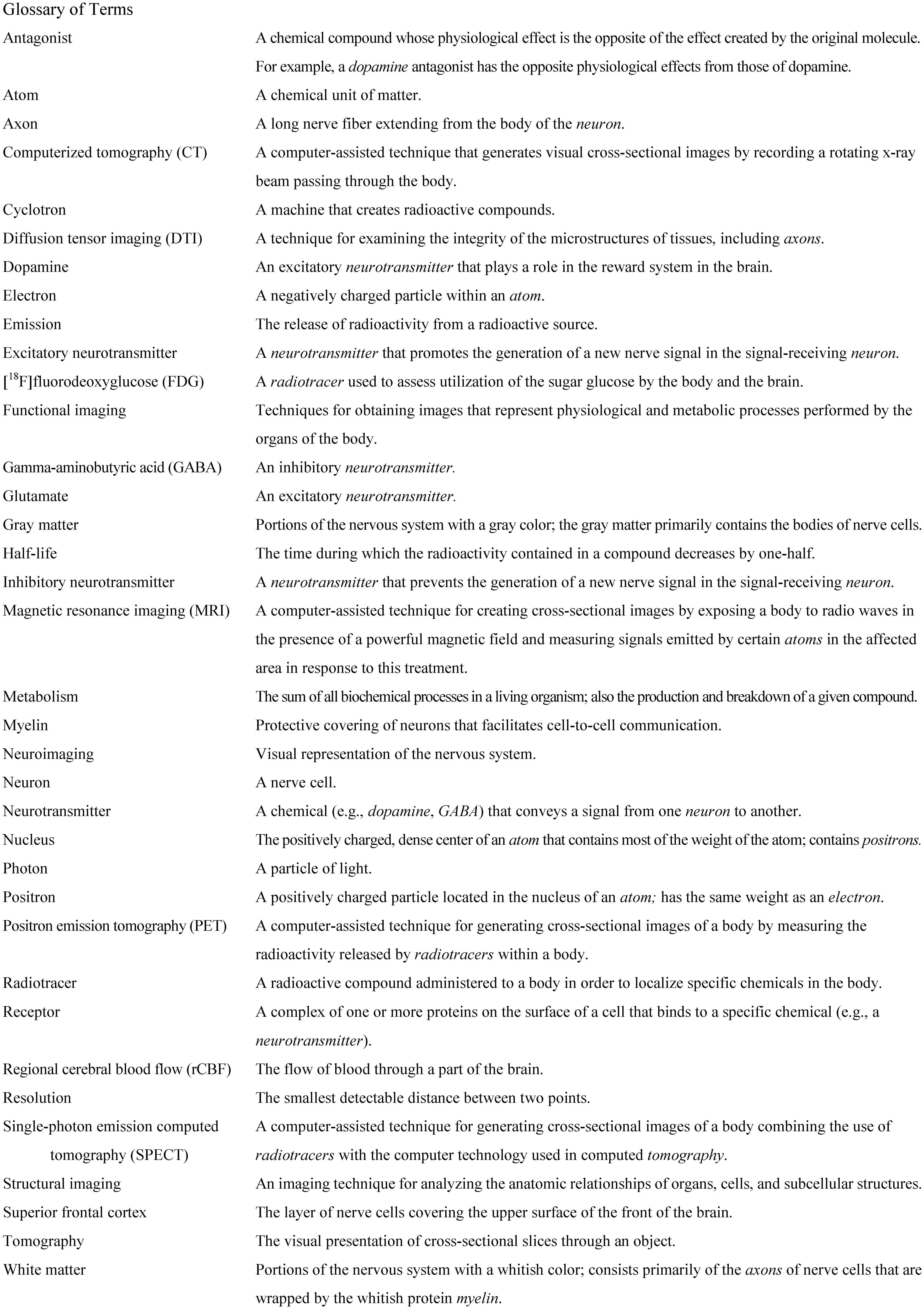









 DownLoad:
DownLoad:



